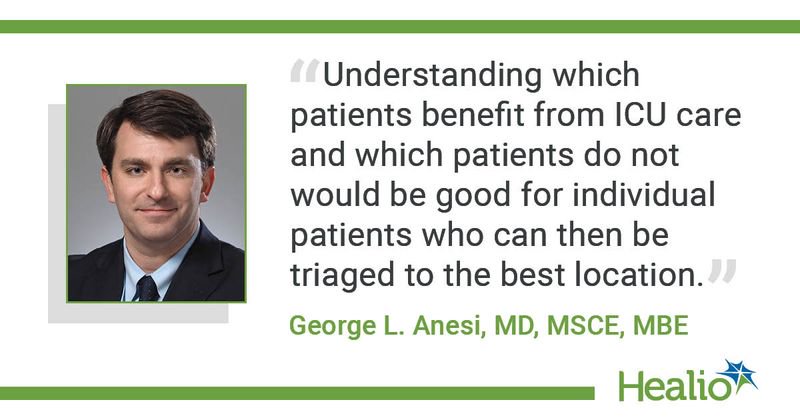Triage to ICU or ward for sepsis, acute respiratory failure may optimize outcomes for some
In a new study, high-acuity patients with sepsis not requiring life support in the ED who were admitted directly to the ward, compared with ICU, had shorter length of stay and improved survival.
In contrast, certain patients with acute respiratory failure triaged directly to the ICU, compared with ward, had improved survival, according to data published in the American Journal of Respiratory and Critical Care Medicine.

“Understanding which patients benefit from ICU care and which patients do not would be good for individual patients who can then be triaged to the best location for them, for researchers and ICU leaders seeking to identify best practices and de-adopt harmful practices, and for public health preparedness to maintain ICU capacity for patients who truly benefit including during surges,” George L. Anesi, MD, MSCE, MBE, instructor of medicine in the division of pulmonary, allergy and critical care at University of Pennsylvania Perelman School of Medicine, told Healio.
The retrospective cohort study evaluated benefits of ICU admission for high-acuity patients with sepsis or acute respiratory failure at 27 hospitals across two health systems in the U.S. from 2013 to 2018. The study included 90,150 patients with sepsis (mean age, 73.6 years; 60.7% white) and 45,339 with acute respiratory failure (mean age, 72.9 years; 61.1% white) who did not require mechanical ventilation or vasopressors in the ED. The researchers utilized a two-stage instrumental variable quantile regression with a strong instrument that governed initial admission to the ICU compared with the ward in this patient population.
Twenty percent of patients with sepsis and 29.5% of patients with acute respiratory failure were admitted to the ICU. In-hospital mortality was 17.2% in patients with sepsis and 20.2% in patients with acute respiratory failure. For patients with an initial admission to the ward, 9.5% with acute respiratory failure and 8.5% with sepsis were transferred to the ICU; median time from admission to ICU transfer was 30 hours and 28 hours, respectively.
ICU admission, compared with initial ward admission, was associated with a 1.32-day longer length of stay (95% CI, 1.01-1.63; P < .001) and higher in-hospital mortality (OR = 1.48; 95% CI, 1.13-1.88; P = .004) among patients with sepsis, according to fully-adjusted instrumental variable regression analyses.
In patients with acute respiratory failure, initial ICU admission, compared with the ward, was associated with a 0.82-day shorter length of stay (95% CI, –1.17 to –0.46; P < .001) and reduced in-hospital mortality (OR = 0.75; 95% CI, 0.57-0.96; P = .04).
When the researchers evaluated length of stay in sensitivity analyses excluding death, results were similar among patients with sepsis but not among patients with acute respiratory failure.
In subgroup analyses, the longest lengths of stay for patients with sepsis occurred in those aged 73 to 80 years (2.81 days), 81 to 87 years (1.89 days) and older than 87 years (3.03 days). Patients with acute respiratory failure aged older than 86 years experienced the shortest length of stay with 1.98 days less. Patients with sepsis aged 73 to 80 years (OR = 1.42; 95% CI, 0.8-2.52), 81 to 87 years (OR = 1.58; 95% CI, 0.85-2.91) and older than 87 years (OR = 1.10; 95% CI, 0.56-2.28) experienced higher in-hospital mortality compared with patients with acute respiratory failure aged older than 86 years (OR = 0.85; 95% CI, 0.44-1.73).
Also in the subgroup analyses, researchers observed longer length of stay among patients with sepsis and fewer comorbidities with a Comorbidity Point Score v2 of 0-55 (2.1 days) and 56-93 (3.56 days), compared with patients with acute respiratory failure in whom those with more comorbidities with a Comorbidity Point Score v2 of 162-420 (0.65 days) had a shorter length of stay. In addition, patients with sepsis and fewer comorbidities with a Comorbidity Point Score v2 of 0-55 (OR = 1.9; 95% CI, 0.85-4.04) and 56-93 (OR = 2.05; 95% CI, 1.04-4.17) had higher in-hospital mortality compared with patients with acute respiratory failure where those with more comorbidities and a Comorbidity Point Score v2 of 162-420 (OR = 0.84; 95% CI, 0.52-1.40) had reduced in-hospital mortality.
“Among patients who are quite sick but not the most sick, those with acute respiratory failure appeared to do better when cared for in an ICU and those with sepsis appeared to do better when cared for outside of the ICU on a regular nursing floor,” Anesi told Healio.
Anesi said the findings do not apply to the sickest patients requiring life support therapy such as mechanical ventilation and vasopressors for shock.
According to Anesi, because results differed between patients with respiratory failure and patients with sepsis, it suggests that the benefits and risks of ICU care also differ by patient type. Therefore, triage decisions may need to be more tailored to the patient and their acute diagnoses, Anesi noted.
“This is a hard question to study, not lending itself well to a randomized trial, and therefore required a nuanced statistical handling of observational data,” Anesi said. “We welcome efforts to replicate these findings, to study other common diagnoses often admitted to ICUs and to understand what practice differences account for the observed results.”
For more information:
George L. Anesi, MD, MSCE, MBE, can be reached at george.anesi@pennmedicine.upenn.edu; Twitter: georgeanesi.
